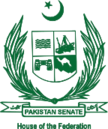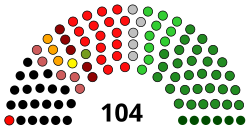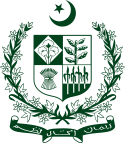Senate of Pakistan
Senate of Pakistan ایوانِ بالا پاکستان | |
|---|---|
 | |
| Type | |
| Type | Upper House of the Majlis-e-Shoora |
Term limits | 6 years |
| History | |
New session started | March 12, 2018 (2018-03-12) |
| Leadership | |
Chairman | Mir Sadiq Sanjrani Ind since 12 March 2018 |
Deputy Chairman | Saleem Mandviwalla PPP since 12 March 2018 |
Leader of the House | Syed Shibli Faraz PTI since 26 August 2018 |
Leader of Opposition | Raja Zafar-ul-Haq PML-N since 26 August 2018 |
| Structure | |
| Seats | 104 |
 | |
Political groups | Government Coalition (40)
Opposition (64)
|
| Elections | |
Voting system | Single transferable vote |
Last election | 3 March 2018 |
Next election | March 2021 (Expected) |
| Meeting place | |
| Senate Secretariat Parliament Building Islamabad, Pakistan | |
| Website | |
| www.senate.gov.pk | |
Pakistan |
|---|
 |
This article is part of a series on the politics and government of Pakistan |
Constitution
|
Government
Parliament
Executive:
Judiciary
|
Elections
|
Administrative units
|
Federalism
|
Foreign relations
|
|
Senate of Pakistan or Aiwān-e-Bālā Pākistān (Urdu: ایوانِ بالا پاکستان, IPA: [ɛːʋɑːn-e bɑːlɑ ˌpɑːkɪst̪ɑːn]) is the upper legislative chamber of the bicameral legislature of Pakistan, and together with the Qaumi Assembly makes up the Majlis-e-Shoora.
First convened in 1973, the Senate's composition and powers are established by the Article 59 of the Constitution of Pakistan.[1] Each province of Pakistan are represented by fourteen senators and eight senators from the tribal areas regardless of population, who serve staggered six-year terms.[2] The Senate secretariat is located in the east wing of the Parliament Building; the National Assembly convenes in the west wing of the same building.[3]
The Senate has several exclusive powers not granted to the National Assembly, including the powers of making parliamentary bills as a being enforced into law. Elections are held every three years for one half of the Senate and each Senator has a term of six years.[4] The Constitution does not allow for the dissolution of the Senate.[5]
Contents
1 History
2 Purpose and role
2.1 President and Parliament
2.2 Relations between the Houses
2.3 Cabinet
2.4 Appointment
3 See also
4 References
5 External links
History
After Independence, the first Constituent Assembly of Pakistan, elected in December 1947 after partition, was assigned the task of framing the Constitution of Pakistan. This Assembly passed the Objectives Resolution on 12 March 1949, laying down principles which later became substantive part of the Constitution of Pakistan. However, before it could accomplish the task of framing the constitution, it was dissolved in October, 1954. Thereafter, the Governor General, convened the Second Constituent Assembly in May, 1955, which framed and passed the first Constitution of Pakistan on 29 February 1956. That Constitution was promulgated on 23 March 1956, which provided for a parliamentary form of Government with a unicameral legislature. However, from 14 August 1947 to 1 March 1956 the Government of India Act 1935, was retained as the Constitution of Pakistan.
On October 7, 1958, Martial Law was promulgated and the Constitution abrogated. The Military Government appointed a Constitution Commission in February, 1960 which framed the 1962 Constitution. That Constitution provided for a Presidential form of Government with a unicameral legislature. The 1962 Constitution was abrogated on 25 March 1969. The Civil Government, which came to power in December 1971 pursuant to 1970 elections, gave the nation an interim Constitution in the year 1972.
The 1970 Assembly framed the 1973 Constitution which was unanimously passed on 12 April and promulgated on 14 August 1973. The 1973 Constitution provides for a parliamentary form of Government with a bicameral legislature, comprising the National Assembly and the Senate.
The membership of the Senate, which was originally 45, was raised to 63 in 1977 and to 87 in 1985. The government of Gen. Pervez Musharraf raised the membership of the Senate from 87 to 100 through the Legal Framework Order (LFO), 2002, enforced on 21 August 2002 and the government of Asif Ali Zardari raised the membership of the Senate from 100 to 104 through the 18th amendment in 2011 (four minority members from four provinces).
Purpose and role
The main purpose for the creation of the Senate of Pakistan was to give equal representation to all the federating units since the membership of the National Assembly was based on the population of each province. Equal provincial membership in the Senate, thus, balances the provincial inequality in the National Assembly.
There are one hundred and four senatorial seats. There are 18 women Senators; Pakistani constitution requires that there be at least 17 women Senators. Members of the Senate are elected according to Article 59 of the Constitution.
President and Parliament
Under Article 50 of the Constitution, the Majlis-i-Shoora (Parliament) of Pakistan consists of the President and two Houses to be known respectively as the National Assembly and the Senate. The President is elected by members of both Houses of the Parliament and the Provincial Assemblies. The President may be removed from office or impeached through a resolution, passed by not less than two-thirds of the total membership of the Parliament in a joint sitting of the two Houses, convened for the purpose.
In the event that the office of the President becomes vacant, the Chairman of the Senate acts as President till such time that the position may be filled through a byelection. This also occurs when the President, by reason of absence or any other incapacity, is unable to effectively exercise their office.
Relations between the Houses
Unless both the Houses pass a Bill and it receives President's assent it cannot become a law except in the case of a money bill which is the sole prerogative of the National Assembly. Through an amendment, the role of a Mediation Committee, composed of eight members of each House, has been introduced to evolve consensus on Bills, in case there is a disagreement between the two houses.
Cabinet
The Constitution provides that there shall be a Cabinet headed by the Prime Minister which is collectively responsible to the National Assembly. The Prime Minister is chosen from the National Assembly. The Federal Ministers and Ministers of State are appointed from amongst the members of Parliament. However, the number of Federal Ministers and Ministers of State who are members of Senate, shall not at any time, exceed one fourth of the numbers of Federal Ministers.
| Province/Territory | General seats | Technocrats/Ulema | Women | Non-Muslim | Total |
|---|---|---|---|---|---|
| Balochistan | 14 | 4 | 4 | 1 | 23 |
| Khyber Pakhtunkhwa | 14 | 4 | 4 | 1 | 23 |
| Sindh | 14 | 4 | 4 | 1 | 23 |
| Punjab | 14 | 4 | 4 | 1 | 23 |
| Tribal Areas (FATA) | 8 | 8 | |||
| Islamabad Capital Territory | 2 | 1 | 1 | 4 | |
| Total | 66 | 17 | 17 | 4 | 104 |
- Four seats for non-Muslims increased through the Constitution (Eighteenth Amendment) Act, 2010 (Act No. X of 2010).
Appointment
(1) The Senate shall consist of 104 members, of whom:
- (a) 14 shall be elected by the members of each Provincial Assembly;
- (b) eight shall be elected by direct and free vote from the Federally Administered Tribal Areas, in such manner as the President may, by Order, and by law prescribe;
- (c) two on general seats, and one woman and one technocrat including aalim shall be elected from the Federal Capital in such manner as the President may, by Order, prescribe;
- (d) four women shall be elected by the members of each Provincial Assembly;
- (e) four technocrats including ulema shall be elected by the members of each Provincial Assembly.
- (f) one seat in the senate is reserved for minorities in each province."
(2) Election to fill seats in the Senate allocated to each Province shall be held in accordance with the system of proportional representation by means of the single transferable vote.
(3) The Senate shall not be subject to dissolution but the term of its members of parliaments, who shall retire as follows, shall be six years:-
- (a) of the members referred to in paragraph (a) of clause (1), seven shall retire after the expiration of the first three years and seven shall retire after the expiration of the next three years.
- (b) of the members referred to in paragraph (b) of the aforesaid clause, four shall retire after the expiration of the first three years and four shall retire after the expiration of the next three years
- (c) of the members referred to in paragraph (c) of the aforesaid clause,-
- (i) one elected on general seat shall retire after the expiration of the first three years and the other one shall retire after the expiration of the next three years, and
- (ii) one elected on the seat reserved for technocrat shall retire after first three years and the one elected on the seat reserved for woman shall retire after the expiration of the next three years;
- (d) of the members referred to in paragraph (d) of the aforesaid clause, two shall retire after the expiration of the three years and two shall retire after the expiration of the next three years; and
- (e) of the members referred to in paragraph (e) of the aforesaid clause, two shall retire after the expiration of the first three years and two shall retire after the expiration of the next three years: Provided that the term of office of a person elected to fill a casual vacancy shall be the unexpired term of the member whose vacancy he has filled.
See also
- Chairman of the Senate of Pakistan
- List of senators of Pakistan
- List of committees of the Senate of Pakistan
- National Assembly of Pakistan
- Government of Pakistan
References
^ "History of Senate". www.senate.gov.pk. Retrieved 26 November 2017..mw-parser-output cite.citation{font-style:inherit}.mw-parser-output .citation q{quotes:"""""""'""'"}.mw-parser-output .citation .cs1-lock-free a{background:url("//upload.wikimedia.org/wikipedia/commons/thumb/6/65/Lock-green.svg/9px-Lock-green.svg.png")no-repeat;background-position:right .1em center}.mw-parser-output .citation .cs1-lock-limited a,.mw-parser-output .citation .cs1-lock-registration a{background:url("//upload.wikimedia.org/wikipedia/commons/thumb/d/d6/Lock-gray-alt-2.svg/9px-Lock-gray-alt-2.svg.png")no-repeat;background-position:right .1em center}.mw-parser-output .citation .cs1-lock-subscription a{background:url("//upload.wikimedia.org/wikipedia/commons/thumb/a/aa/Lock-red-alt-2.svg/9px-Lock-red-alt-2.svg.png")no-repeat;background-position:right .1em center}.mw-parser-output .cs1-subscription,.mw-parser-output .cs1-registration{color:#555}.mw-parser-output .cs1-subscription span,.mw-parser-output .cs1-registration span{border-bottom:1px dotted;cursor:help}.mw-parser-output .cs1-ws-icon a{background:url("//upload.wikimedia.org/wikipedia/commons/thumb/4/4c/Wikisource-logo.svg/12px-Wikisource-logo.svg.png")no-repeat;background-position:right .1em center}.mw-parser-output code.cs1-code{color:inherit;background:inherit;border:inherit;padding:inherit}.mw-parser-output .cs1-hidden-error{display:none;font-size:100%}.mw-parser-output .cs1-visible-error{font-size:100%}.mw-parser-output .cs1-maint{display:none;color:#33aa33;margin-left:0.3em}.mw-parser-output .cs1-subscription,.mw-parser-output .cs1-registration,.mw-parser-output .cs1-format{font-size:95%}.mw-parser-output .cs1-kern-left,.mw-parser-output .cs1-kern-wl-left{padding-left:0.2em}.mw-parser-output .cs1-kern-right,.mw-parser-output .cs1-kern-wl-right{padding-right:0.2em}
^ [Article 59(1)(a)-59(1)(c) in Chapter 2: The Parliament of Part III: The Federation of Pakistan in the Constitution of Pakistan
^ Google maps. "Parliament House, Pakistan". www.google.com/maps. Retrieved 23 May 2015.
^ [Article 59(3)(a) in Chapter 2: The Parliament of Part III: The Federation of Pakistan in the Constitution of Pakistan
^ [Article 59(3) in Chapter 2: The Parliament of Part III: The Federation of Pakistan in the Constitution of Pakistan
External links
- Official web site of the Senate of Pakistan


